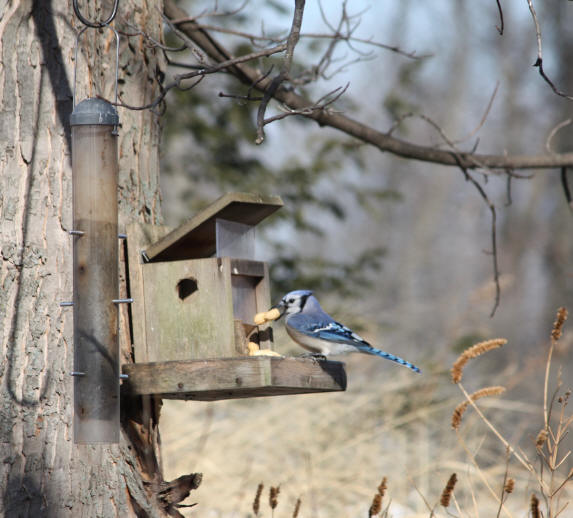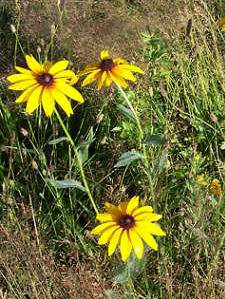Kay Hinkle
Adams County Master Gardener

Now that we have turned back the clocks, raked our leaves, and put our gardens to bed for winter, our thoughts turn to preparation for the coming holidays. As you read this article, my favorite holiday is upon us. Thanksgiving means many things to
many people – a time to give thanks for our many blessings, a time to get creative with cooking and decorating, and of course, time to start thinking about the approaching Christmas holiday!
To birds that don’t migrate south for the winter, Thanksgiving brings the onset of colder weather and a need to find enough food to maintain their body temperatures. This means that they must search for food from sun up to dusk. Fortunately for the
birds, 41 million Americans spend $2 billion annually on bird feeding according to the U.S. Fish and Wildlife Service.
When temperatures dip the insect supply is diminished. Once snow covers the ground, natural seeds are covered and berries and crab apples are gone. The food you provide for the birds that inhabit your area is important to the bird’s ability to
maintain their 108-degree body temperature necessary for survival.
Fatty foods are important for our winter birds. Suet from hard beef fat inexpensive and can be mixed with seeds, peanut butter or cornmeal and appeals to a wide variety of species. Peanut butter is more expensive than suet but can be melted down and
mixed with suet for a tasty treat. Be very careful when using kitchen fat from cooking that it doesn’t contain much seasoning like salt or spices – mix it with cornmeal or flour if you plan to serve it to birds.
Seeds contain high levels of carbohydrates that are turned into glucose that meet the birds’ high energy demands. They are also a good source of vitamins and protein. If you buy a pre-mixed bag of seeds, look for those high in sunflower seeds and
white proso millet. Avoid those containing fillers like wheat seeds and milo.

Black oil sunflower seeds have soft outer shells compared to the striped variety, making it easier for birds like cardinals and juncos to get to the kernel inside. The black oil sunflower seeds are less expensive and have a greater amount of
vegetable oil to help supply the energy birds need to maintain their body heat.
Millet contains 10% protein and 4% starch. Cracked corn appeals to a wide range of birds including juncos, cardinals, doves and sparrows. Niger seed is expensive but attracts finches; hulled sunflower seeds are less expensive and attract finches as
well. Nutmeats provide oil for energy, too but are somewhat expensive. A good mix of seeds you can make yourself includes 50% un-hulled oil sunflower seeds, 3 5% white proso millet, and 15% finely cracked corn.
When choosing a spot for your bird feeding area, select an area that is 5-10 feet away from a bush or tree to provide cover from prey. More than one feeder prevents one bird from monopolizing the feeder. A year-round water supply is best for what can
be difficult to find in freezing weather. Use a birdbath heater with a built-in thermostat to keep the water from freezing. Clean the birdbath regularly with a solution of 5-10% chlorine bleach. Never treat the water with chemicals.

In addition to man-made feeders and food that will attract birds to your yard, design your landscape to create an inviting environment. First look at plant components in your yard – evergreens or conifers provide great winter shelter for birds. Some
birds use trees for roosting at night - others for cover or a stop on the way to the feeder. Fruit and nut-bearing trees like the eastern red cedar, persistent crabapple, sumac, and mountain ash all provide clusters of fruit throughout the year.
|

Black-eyed Susan
Rudbeckia hirta |
Another way to provide cover for your birds in winter is to leave perennials standing through the winter months. Black-eyed Susans, purple coneflowers, and gloriosia daisies provide seeds for birds like goldfinches.
Brush piles are important for migrating birds so they can rest and hide from birds of prey. A dead tree, or "snag" will attract more than 40 species that include the nuthatch and tree swallow. Larger birds like the pileated woodpecker like a larger
snag.
Living on the edge of a woodland, I have found that the natural cover that trees provide allows for a wide variety of feathered friends around our home. As fall approaches, I only cut back some of the perennials, allowing all grasses to stand. The
autumn joy sedum with large seedheads stay also, as do the black-eyed susans and coneflowers that have not yet nodded their way to the ground at summer’s end.
We have enjoyed a wide variety of birds through all kinds of winter weather with several feeders placed 10-15 feet apart near the edge of the woods. Our fishpond waterfall runs continuously through cold weather with help of a heater submerged in the
water when sub-freezing weather persists.
We feed the squirrels about 30 feet away from feeders with corn and nuts and they aren’t so inclined to invade the bird feeders. We have also used PVC pipe for mounting bird feeders to deter the squirrels; however, they still attempt to jump onto
bird feeders from distant trees and are sometimes successful!
Once they have made such a valiant effort to get a taste of the forbidden, I think the little critters deserve to steal a treat and don’t bother to chase them away. While not all of us are so relaxed about squirrels at the bird feeder, I have to say
that I admire their ingenuity and vow to be just a bit more like them.
Don’t get the wrong idea; I don’t encourage stealing food from others, although I have been known to steal a bite of my husband’s dessert at dinner. It is the squirrels’ ingenuity that intrigues me most. They don’t give up until they have reached
their goal and demonstrate a level of creativity that is enviable to me. As a result, striving to be more "squirrel-y" in that regard isn’t such a bad thing, now is it?
Read other articles on birds, wildlife & beneficial insects
Read other winter related gardening articles